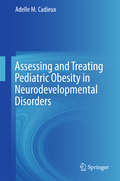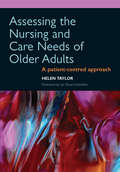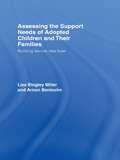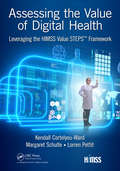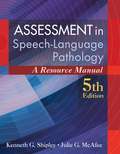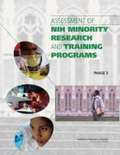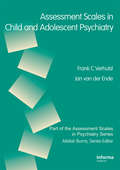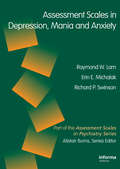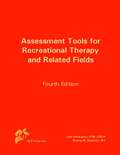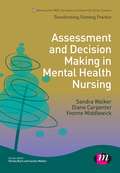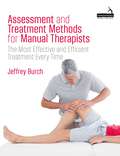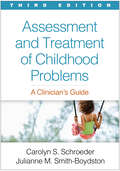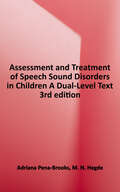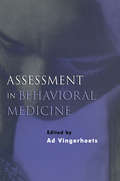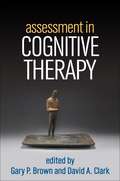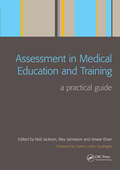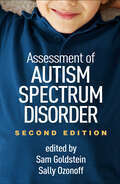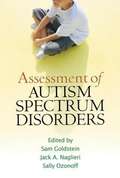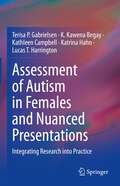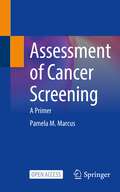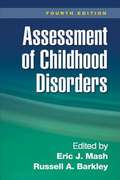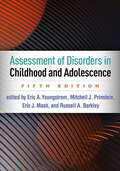- Table View
- List View
Assessing and Treating Pediatric Obesity in Neurodevelopmental Disorders
by Adelle M. CadieuxThis book reviews strategies for assessing and treating pediatric obesity in children with neurodevelopmental disorders (ND). It synthesizes empirical findings and clinical strategies to offer the latest knowledge in key areas, including risk factors, physical activity, nutrition, treatment planning, goal-setting, and engagement with patients. A four-stage treatment model presents clinical guidance in triaging treatment and tailoring interventions to children's changing medical, behavioral, emotional, and cognitive needs. The book complements current pediatric ND literature by presenting clear guidelines for integrating treatment for obesity into existing treatment of these young patients. Topics featured in this book include: The effect of neurodevelopmental disorders on the assessment of obesity in children. The impact of developmental delays on physical activities and health behaviors. Strategies for promoting weight management goals in pediatric ND. Suggestions on how to engage and support families and caregivers. The role of prevention in weight management within pediatric ND. Assessing and Treating Pediatric Obesity in Neurodevelopmental Disorders is a must-have resource for clinicians, scientist-practitioners, and related professionals as well as researchers, professors, and graduate students in clinical child and school psychology, public health, social work, pediatrics, occupational therapy, and nutrition.
Assessing the Implications of Allowing Transgender Personnel to Serve Openly
by Agnes Gereben Schaefer Jennifer Kavanagh Kayla M. Williams Srikanth Kadiyala Radha Iyengar Amii M. Kress Charles C. EngelThe U.S. Department of Defense is considering a change in policy to allow transgender military personnel to serve openly. A RAND study examined the health care needs of transgender personnel, the costs of gender transition-related care, and the potential readiness implications of a policy change. The experiences of foreign militaries that permit transgender service members to serve openly also point to some best practices for U.S. policymakers.
Assessing the Nursing and Care Needs of Older Adults: A Patient-Centred Approach
by Helen TaylorHealth resources are becoming increasingly constrained. So it is essential that professionals, and the public, recognise the need to work together in establishing local priorities and collaborate in their implementation. Priority Setting and The Public challenges many widely accepted beliefs and perceptions. It links together academic literature, critical overviews of methods and approaches with practical applications and original research. It shows the different approaches to engaging the public, challenges and how progress can be achieved. A wide number of methods, from a range of disciplines are described, reviewed and guidance is given on factors to consider for selection. This book is essential reading for all health service and primary care organisations, especially those responsible for resource allocation, clinical governance and public health.
Assessing the Support Needs of Adopted Children and Their Families: Building Secure New Lives
by Arnon Bentovim Liza Bingley MillerWritten in consultation with a range of experts, clinicians and practitioners as well as adoptive children, families and birth relatives, this book gives helpful guidance on making evidence-based assessments and planning successful adoption support. Key features include: a discussion of the main themes of adoption and pointers for practice in relation to the Assessment Framework a guide to the use of evidence-based approaches to assessment, including the tools commissioned by the Department of Health and the Department for Education a model for analysis and planning, and planning support and interventions an investigation of the source, range and value of support services and interventions that can promote the wellbeing of adopted children, their adoptive families and birth relatives. Packed with practical advice, case examples and models of good practice, this book is invaluable for social workers and managers involved with the adoption process and the well-being of children and families. It is also essential reading for social work students learning about working with children and families.
Assessing the Value of Digital Health: Leveraging the HIMSS Value STEPS™ Framework (HIMSS Book Series)
by Kendall Cortelyou-Ward Margaret Schulte Lorren PettitHIMSS set out to develop a dynamic framework by which to easily catalogue the varied beneficial evidences of digital health. From this effort, HIMSS introduced to the market the HIMSS Value STEPS™ framework. This book will leverage the HIMSS Value STEPS™ model to identify and define the expressions of value the use of health IT systems can yield per the following domains: Satisfaction, Treatment/Clinical, Electronic Secure Data, Patient Engagement and Population Health, and Savings. Using this framework, HIMSS has developed a collection of over 2,000 cases reflecting the value that hospitals, health systems and other providers have experienced following implementation of their electronic health record and/or other IT-related applications. The more than 17,000 value statements that have been extracted from the 2,000+ case articles have been classified within 85 Standard Value Standard (SVS) within the five STEPS domains. The book will describe the STEPS model to demonstrate the impact of health IT in healthcare organizations, and the quality of care and overall financial and operational performance improvements that have been achieved.
Assessment In Speech-language Pathology: A Resource Manual
by Kenneth Shipley Julie McAfeeThis trusted, best-selling text has become an essential, invaluable resource for clinicians, instructors, and students in the dynamic field of speech-language pathology. Accessible, visually engaging, and easy to navigate, this highly practical manual provides comprehensive coverage of a wide range of disorders and the procedures and materials used in their diagnosis, evaluation, and treatment in both pediatric and adult populations. Now better than ever, ASSESSMENT IN SPEECH-LANGUAGE PATHOLOGY: A RESOURCE MANUAL, 5E, is completely current, with new and updated content in every chapter reflecting the latest research, best practices, and important trends and developments. <p><p> Highlights include new chapters on autism spectrum disorders and assessment of clients who require augmentative and alternative communication (AAC), and a new chapter dedicated to norms, charts, and reference tables. In addition, the authors have significantly revised chapters on voice disorders and the foundations of assessment and added new material on childhood apraxia of speech, apps, online test sites, and electronic media. <p> Also new to the Fifth edition, the text's vast collection of forms for obtaining, interpreting, and reporting assessment data are now available online, making them even easier to customize, reproduce, and use in the classroom or a wide variety of clinical settings.
Assessment Of Nih Minority Research And Training Programs: Phase 3
by National Research Council of the National AcademiesThis report provides an assessment of NIH’s programs for increasing the participation in biomedical science of individuals from underrepresented minority groups. The report examines, using available data and the results of a survey of NIH trainees, the characteristics and outcomes of programs at the undergraduate, graduate, postdoctoral, and junior faculty levels. The report provides recommendations for improving these programs and their administration. It also recommends how NIH can improve the data it collects on trainees in all NIH research training programs so as to enhance training program evaluation.
Assessment Scales in Child and Adolescent Psychiatry (Assessment Scales in Psychiatry Series)
by Frank C. Verhulst Jan van der EndeMental disorders such as attention-deficit hyperactivity disorder (ADHD), depression, and autism have devastating consequences on the lives of children and adolescents. Early assessment of their mental health problems is essential for preventative measures and intervention. This timely, authoritative guide will be of interest to everyone involved i
Assessment Scales in Depression and Anxiety - CORPORATE: (Servier Edn)
by Raymond W. Lam Erin E. Michalaak Richard P. SwinsonThere are a number of books recently published on assessment scales for depression and anxiety. However, these books are generally more detailed than clinicians require, are specific to one or other condition, or involve specialty populations such as children or geriatrics. To meet the needs of clinicians treating patients with depressive and anxiety disorders, this volume aims to bring together empirically validated assessment scales. In a concise and user-friendly format, Assessment Scales in Depression and Anxiety illustrates the assessment scales used in clinical trials and research studies; shows how to select an assessment scale and to decide which scale to use for a particular clinical situation; and provides sample assessment scales for clinicians to use in their practice.
Assessment Tools For Recreational Therapy And Related Fields
by Joan Burlingame Thomas M. BlaschkoSince its first edition in 1990, this has become the standard reference book on assessment in Recreational Therapy. As with the earlier editions, the purpose of this book is to provide both the therapist and the student with specific, critical information about the assessment process, specific tools, and specific standards related to assessment. The information on national assessments, such as the RAI/MDS for long-term care, is especially important to therapists. The fourth edition has 726 pages with five new assessments and updated information on all national and international standards. This book is used in over fifty colleges and nine different countries.
Assessment and Communication of Risk: A Pocket Text for Health and Safety Professionals
by Eric Liberda Timothy SlyThis is the long-awaited pocket text on risk assessment for students and professionals in all health and safety fields. Risk assessment and risk-based decision-making are essential skills in today’s health and safety fields, but a convenient pocket or desk reference has been needed with enough theory to begin a preliminary risk assessment, together with clear explanations, applications, and worked examples. This book addresses that need. It provides a practical resource for estimating risks in various applications, as well as assisting with the design of larger project-based assessments. It explains the two main numeric procedures: probabilistic, or “catastrophic”, and quantitative, or “chronic”, risk assessment, along with chapters on qualitative risk assessment and approaches to food-related risks. A final chapter examines how people perceive risk, and provides advice and assistance in the development of essential, effective risk communication with the public and with the media. Numerous case studies are analyzed. Assessment and Communication of Risk: A Pocket Text for Health and Safety Professionals is a one-stop resource for students in all health and safety fields, and provides a valuable guide for existing field practitioners in public health, occupational health and safety, hospitals, environmental assessment offices, and ministries of health, labour, and the environment.
Assessment and Decision Making in Mental Health Nursing (Transforming Nursing Practice)
by Diane Carpenter Yvonne Middlewick Sandra WalkerAssessment is an essential part of mental-health nursing and as such a core learning requirement for pre-registration nursing students. Getting assessment right is essential for the nursing student in order for them to become an effective practitioner. Many books on assessment are very theoretical. This is a practical, hands-on guide to the assessment process, underpinned by the latest evidence. The book explains the core principles through running case studies, so that readers can see how each decision they make impacts on the person in their care. Key features: Assessment principles are applied across a variety of modern nursing settings that you may find yourself working in as a registered nurse Each chapter is linked to the relevant NMC standards and Essential Skills Clusters so you know you are meeting the professional requirements Activities throughout help you to think critically and develop essential graduate skills.
Assessment and Treatment Methods for Manual Therapists: The Most Effective and Efficient Treatment Every Time
by Jeffrey BurchEffectively assessing clients and knowing how to treat them is the cornerstone of manual therapy. This practical and informative book gives clear and detailed information about these two steps. The book provides step-by-step instructions (including Illustrations) for 19 assessment methods and 24 gentle treatment methods, some of which appear in print for the first time. These methods can be combined to give multiple options for treatment, as demonstrated in five practical examples which demonstrate how the practitioner can apply the methods to improve their clients' wellbeing. The author also describes his six-axis model of variance among treatment methods, which will be particularly useful for practitioners who may want to develop additional new treatment methods of their own.Jeff Burch seeks to demystify the complex and often inconsistent terminology found in many manual therapy texts, making this a practical text for readers of all levels. It will be a useful tool for osteopaths, massage therapists, chiropractors, occupational therapists, physical therapists, structural integrators, and all bodyworkers.
Assessment and Treatment of Childhood Problems, Third Edition: A Clinician's Guide
by Carolyn S. Schroeder Julianne M. Smith-BoydstonThis highly accessible work, now thoroughly revised, has shown thousands of students and clinicians how to assess and treat children's emotional and behavioral difficulties from a developmental perspective. The authors provide a sound understanding of typical development (ages 2-12) and the risk and protective factors for psychopathology. Chapters on common psychological disorders and family stressors describe the nature of each problem, review evidence-based treatments, and offer step-by-step guidelines for intervention, illustrated with helpful case examples. A comprehensive framework for assessing children and planning treatment is used throughout. Purchasers get access to a Web page where they can download and print the book's 24 reproducible forms and handouts in a convenient 8 1/2" x 11" size. New to This Edition: *Chapters on developmental disabilities and trauma. *Significantly revised to reflect advances in assessment, treatment, and developmental psychopathology research. *Additional material on pharmacological treatments in each disorder-specific chapter. *Sibling rivalry chapter expanded to include difficulties with peers. *Updated for DSM-5.
Assessment and Treatment of Speech Sound Disorders in Children: A Dual Level Text
by M. N. Hegde Adriana Peña-BrooksThis book is the revision of Assessment and Treatment of Articulation and Phonological Disorders in Children, Second Edition. It serves both introductory undergraduate courses and advanced courses for graduate seminars on speech sound disorders. Written in a student-friendly style, this text makes it easier to understand basic phonology vocabulary, approaches, perspectives, theories, and assessment and treatment techniques for speech sound disorders. This third edition includes substantial revisions that reflect advances in the study and treatment of speech sound disorders. <p><p>In addition to updating research in each chapter, two new chapters have been added. A new introductory chapter defines and describes speech sound disorders and distinguishes articulation disorders from phonological disorders. The second new chapter, Chapter 9, addresses the issue of phonological awareness as it relates to speech sound disorders. All remaining chapters have been revised to reflect the recent trends, research, and theories and the reorganized chapters facilitate a better flow of information. Resources CD included useful therapy materials.
Assessment in Behavioral Medicine
by Ad VingerhoetsHow can the influence of behavioral factors on health and well-being be measured? Research over the past two decades has shown that psychological factors and lifestyle have been found to be relevant to the onset and course of disease. In addition, these factors codetermine how patients and those in their social environment cope with illness and what their quality of life is. Assessment in Behavioral Medicine gives the reader a greater understanding of the influence of behavioral factors on somatic health. There is a continuing need for research to better our understanding of the processes that play a crucial role in the influence of psychosocial factors on health. However, the proliferation of tools for assessing psychosocial and psychobiological factors makes it difficult to make an optimal choice of measurement. This volume aims to advance the state of measurement in the multidisciplinary fields of behavioral medicine and health psychology by bringing together state-of-the-art theory and research on assessment issues in this area. It provides the reader with an insight into the different kinds of measures that are available, along with practical guidelines for choosing the appropriate tools and designs to meet specific research questions. Assessment in Behavioral Medicine is a unique resource for students, researchers, clinicians and teachers who are involved in education, research or clinical work in which measuring behavioral and psychosocial factors is a crucial activity.
Assessment in Cognitive Therapy
by David A. Clark Gary P. BrownThis volume brings together leading experts to explore the state of the art of cognitive clinical assessment and identify cutting-edge approaches of interest to clinicians and researchers. The book highlights fundamental problems concerning the validity of assessments that are widely used in cognitive-behavioral therapy (CBT). Key directions for further research and development are identified. Updated cognitive assessment methods are described in detail, with particular attention to transdiagnostic treatment, evidence-based practice, cognitive case formulation, and imagery-based techniques.
Assessment in Medical Education and Training: A Practical Guide
by Alex Jamieson Neil Jackson Anwar KhanThis work contains a foreword by Dame Lesley Southgate, President, Royal Free and University College Medical School, London. Assessment is a key method of improving standards as well as establishing competency. However, despite major developments in the assessment of clinical competence in the last two decades, there is still more bad practice and ignorance of significant issues in this area than any other aspect of medical higher education. This book comprehensively covers all aspects of assessment. It considers current and future policy and practice, including the Modernising Medical Careers training programme; it promotes a system incorporating more meaningful assessments, rather than just 'tests' of knowledge and skill. "Assessment in Medical Education and Training" will be useful to everyone involved in healthcare education, including tutors, trainers, clinical supervisors and assessors in both primary and secondary care. It will also be important reading for consultants and general practitioners with responsibility for registrars, and healthcare education policy makers and shapers. 'Acquisition of knowledge and skills is not sufficient alone; we need to be able to apply the knowledge, skills and strategies learnt, and in turn these can be the appropriate targets of assessment. There is a movement away from traditional, multiple-choice tests to assessments that include a wide variety of methods and so provide for more meaningful assessments which can better capture significant outcomes in order to assure their future success.' - Neil Jackson, Alex Jamieson and Anwar Khan, in the Introduction. 'This thoughtful, provocative and eclectic book is published at a time of enormous change in the content, structure and quality assurance of postgraduate medical education in the United Kingdom. The reader will be challenged and stimulated by the variety of views and emphases. Essential.' - Dame Lesley Southgate, in the Foreword.
Assessment of Agent Monitoring Strategies for the Blue Grass and Pueblo Chemical Agent Destruction Pilot Plants
by Committee on Assessment of Agent Monitoring Strategies for the Blue Grass Pueblo Chemical Agent Destruction Pilot PlantsJanuary 2012 saw the completion of the U. S. Army's Chemical Materials Agency's (CMA's) task to destroy 90 percent of the nation's stockpile of chemical weapons. CMA completed destruction of the chemical agents and associated weapons deployed overseas, which were transported to Johnston Atoll, southwest of Hawaii, and demilitarized there. The remaining 10 percent of the nation's chemical weapons stockpile is stored at two continental U. S. depots, in Lexington, Kentucky, and Pueblo, Colorado. Their destruction has been assigned to a separate U. S. Army organization, the Assembled Chemical Weapons Alternatives (ACWA) Element. ACWA is currently constructing the last two chemical weapons disposal facilities, the Pueblo and Blue Grass Chemical Agent Destruction Pilot Plants (denoted PCAPP and BGCAPP), with weapons destruction activities scheduled to start in 2015 and 2020, respectively. ACWA is charged with destroying the mustard agent stockpile at Pueblo and the nerve and mustard agent stockpile at Blue Grass without using the multiple incinerators and furnaces used at the five CMA demilitarization plants that dealt with assembled chemical weapons - munitions containing both chemical agents and explosive/propulsive components. The two ACWA demilitarization facilities are congressionally mandated to employ noncombustion-based chemical neutralization processes to destroy chemical agents. In order to safely operate its disposal plants, CMA developed methods and procedures to monitor chemical agent contamination of both secondary waste materials and plant structural components. ACWA currently plans to adopt these methods and procedures for use at these facilities. The Assessment of Agent Monitoring Strategies for the Blue Grass and Pueblo Chemical Agent Destruction Pilot Plants report also develops and describes a half-dozen scenarios involving prospective ACWA secondary waste characterization, process equipment maintenance and changeover activities, and closure agent decontamination challenges, where direct, real-time agent contamination measurements on surfaces or in porous bulk materials might allow more efficient and possibly safer operations if suitable analytical technology is available and affordable.
Assessment of Autism Spectrum Disorder, Second Edition
by Sally Ozonoff Sam GoldsteinThis authoritative resource, now thoroughly revised for DSM-5, has set the standard for the comprehensive assessment of autism spectrum disorder (ASD). Leading experts demonstrate how to craft a scientifically grounded profile of each child’s strengths and difficulties, make a formal diagnosis, and use assessment data to guide individualized intervention in clinical and school settings. Chapters review state-of-the-art instruments and approaches for evaluating specific areas of impairment in ASD and co-occurring emotional and behavioral disorders. Considerations in working with children of different ages are highlighted. With a primary focus on children, several chapters also address assessment of adolescents and adults. New to This Edition *Chapter on key implications of DSM-5 diagnostic criteria, plus related updates throughout the volume. *Chapter on advances in early identification (ages 0–3). *Chapter with in-depth case examples illustrating the evaluation decision-making process and common diagnostic challenges. *Chapters on pseudoscience (including strategies for advising parents) and future directions in the field. *Current assessment data, numerous new and revised measures, and cutting-edge screening approaches.
Assessment of Autism Spectrum Disorders
by Sam Goldstein Jack NaglieriSignificant progress has been made in assessing children with autism spectrum disorders, but the field has lacked a single, comprehensive resource that assembles current best practices within a unified assessment framework. This authoritative book demonstrates how to craft a complete, scientifically grounded, and clinically useful portrait of a child's strengths and difficulties in social behavior, language and communication, intellectual functioning, motor skills, and other key areas of impairment and comorbidity. Leading experts illustrate ways in which school and clinical practitioners can integrate data from a variety of sources to improve the accuracy of diagnosis and inform the development of individualized interventions.
Assessment of Autism in Females and Nuanced Presentations: Integrating Research into Practice
by Kathleen Campbell Terisa P. Gabrielsen K. Kawena Begay Katrina Hahn Lucas T. HarringtonThis book examines autism characteristics that may be different than expected (atypical), primarily found in females, but also in others and are likely to be missed or misdiagnosed when identification and support are needed. It follows a lifespan framework, guiding readers through comprehensive assessment processes at any age. The book integrates interpretations of standardized measures, information from scientific literature, and context from first-person accounts to provide a more nuanced and sensitive approach to assessment. It addresses implications for improved treatment and supports based on comprehensive assessment processes and includes case studies within each age range to consolidate and illustrate assessment processes. Key areas of coverage include:Interdisciplinary assessment processes, including psychology, speech and language pathology, education, and health care disciplines.Lifespan approach to comprehensive assessment of autism in females/atypical autism.Guide to interpretation of standardized measures in females/atypical autism.Additional assessment tools and processes to provide diagnostic clarity.Descriptions of barriers in diagnostic processes from first-person accounts.Intervention and support strategies tied to assessment data.In-depth explanations of evidence and at-a-glance summaries. Assessment of Autism in Females and Nuanced Presentations is a must-have resource for researchers, professors, and graduate students as well as clinicians, practitioners, and policymakers in developmental and clinical psychology, speech language pathology, medicine, education, social work, mental health, and all interrelated disciplines.
Assessment of Cancer Screening: A Primer
by Pamela M. MarcusCancer screening is a prominent strategy in cancer control in the United States, yet the ability to correctly interpret cancer screening data eludes many researchers, clinicians, and policy makers. This open access primer rectifies that situation by teaching readers, in simple language and with straightforward examples, why and how the population-level cancer burden changes when screening is implemented, and how we assess whether that change is of benefit. This book provides an in-depth look at the many aspects of cancer screening and its assessment, including screening phenomena, performance measures, population-level outcomes, research designs, and other important and timely topics. Concise, accessible, and focused, Assessment of Cancer Screening: A Primer is best suited to those with education or experience in clinical research or public health in the United States - no previous knowledge of cancer screening assessment is necessary. This is the first text dedicated to cancer screening theory and methodology to be published in 20 years.
Assessment of Childhood Disorders, Fourth Edition
by Eric Mash Russell BarkleyThis leading text and clinical guide offers best-practice recommendations for assessing a comprehensive array of child and adolescent mental health problems and health risks. Prominent authorities present evidence-based approaches that can be used in planning, implementing, and evaluating real-world clinical services. Coverage encompasses behavior disorders, mood disorders, anxiety disorders, developmental disorders, maltreatment, and adolescent problems. The volume emphasizes the need to evaluate clients' strengths as well as their deficits, and to take into account the developmental, biological, familial, and cultural contexts of problem behavior. New to This Edition Incorporates advances in knowledge on child and family disorders and evidence-based assessment. Chapters on bipolar disorder, suicidal and self-harming behaviors, posttraumatic stress disorder, early-onset schizophrenia, learning disabilities, and adolescent personality disorders.
Assessment of Disorders in Childhood and Adolescence
by Russell A. Barkley Mitchell J. Prinstein Eric J. Mash Eric A. YoungstromThis leading course text and practitioner reference has been extensively revised with 90% new content, covering a broader range of child and adolescent problems in more concise chapters. Prominent authorities provide a comprehensive framework for evidence-based assessment. Presented are methods and tools for developing effective diagnoses and case formulations, building strong treatment plans, monitoring progress, and documenting outcomes. Chapters are packed with practical guidance, handy tables, and sample instruments. Illustrative case material is included. Prior edition title: Assessment of Childhood Disorders, Fourth Edition, edited by Eric J. Mash and Russell A. Barkley.
